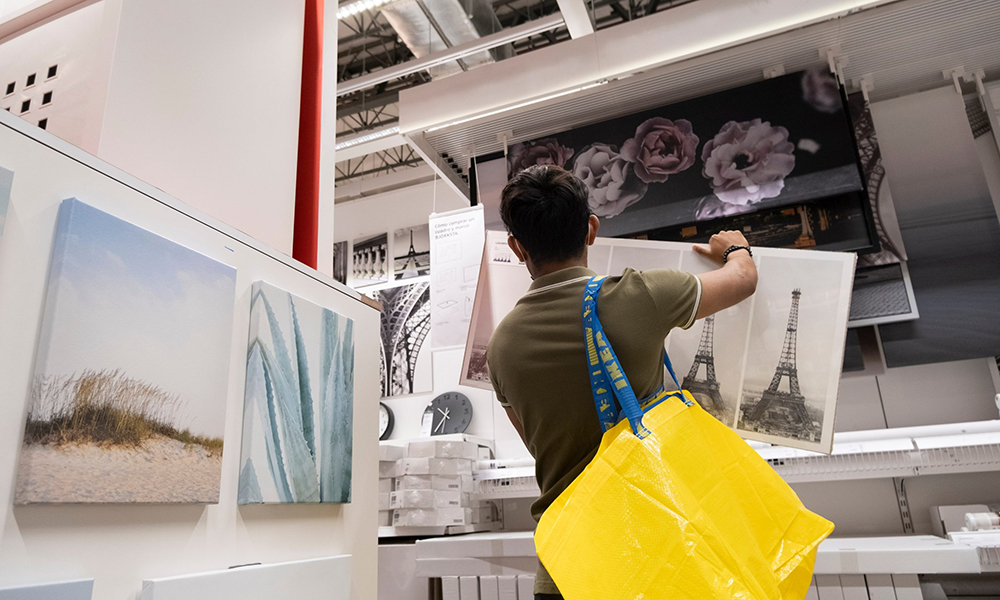
购物者在宜家(IKEA)购物的典型体验是,要走过漫长而曲折的一段路,从一个分区来到另一个分区,才可以最终抵达收银台(以及供应这家家具连锁店标志性的瑞典肉丸的自助餐厅)。
这对一些人来说既费时又费力,为此这家零售商试图改变门店的布局设计,以便让顾客更容易到特定的分区购物。
但事实证明,购物者其实很喜欢并希望能够恢复迷宫般的布局。
最近,这家瑞典家具品牌在世界各地的一些市中心门店中尝试采用不同的布局设计,使其与那些让购物者可以根据自己想买的商品来随意选择路线的商店没有什么两样。据《华尔街日报》(Wall Street Journal)报道,这一新理念的提出是为了迎合临时购物者或者上班族的需求,这类群体可能不愿意为了购买几件商品而逛遍整个宜家门店。
然而,这家零售商的采访和调查结果却显示,这种挑战似乎恰恰是顾客所希冀的。英格卡集团(Ingka Group)的零售主管托尔加·恩居——其运营着宜家的众多门店——在接受《华尔街日报》的采访时表示,购物者希望在整个购物体验中能够受到商店的引导。
恩居说:“我们原本以为由于门店很小,顾客无需引导就可以看到全部商品。但现在看来,顾客显然觉得‘不对,这是一间大商店!’”
迷宫般布局的可贵之处还在于,它能够让购物者在购物过程中发现一些原来没有意识到自己会需要的商品。恩居称,顾客会在途中想起他们“三周前说起过但如今已经抛诸脑后”的商品。
针对新时代购物者的设计
自选路线的门店布局只是宜家近年来为吸引新时代购物者而尝试的众多布局之一。这家零售商尝试过开设小型门店和专门的规划与订购服务中心,以弥补在线购物体验的不足。另外,宜家还在继续尝试以不同的理念来设计其市中心的门店——这些门店不像郊区仓库般的门店那样拥有极宽敞的空间。
目前,宜家关闭了西班牙马德里、中国上海和波兰华沙等城市中顾客可以自选路线的门店。2022年12月,由于客流量不足,这家零售商还关闭了其在美国纽约的城区小型门店,但在英国伦敦的哈默史密斯地区和美国旧金山的市中心开设了类似的店面。
恩居在两周前告诉路透社(Reuters):“我们对自己的城市策略信心十足,它对宜家在城市市场上的现有影响力具有很强的补充作用。”他举出了某间宜家门店的例子,该门店开在位于瑞典斯德哥尔摩的一家购物中心内部,“促使该购物中心的客流量增加了50%”。
英格卡集团没有立即回应《财富》杂志的置评请求。
宜家的成功离不开它独特的门店布局
几十年来,宜家一直是一个家喻户晓的名字。1958年,它在瑞典的艾尔姆胡尔特开设了第一家门店。截至今年2月,该品牌在62个不同的市场拥有460家门店。
宜家的门店占地能够达到数十万平方英尺(数万平方米),如果采用传统的布局设计,进出可能就都得花些时间。这些门店为想要直接前往结账的顾客提供了快捷通道。尽管如此,这种布局却是宜家成功的关键。
宜家的家具通常会按照真实情境摆放,而划出不同的分区则会让购物者感觉仿佛在浏览实体目录。从心理层面上看,蜿蜒曲折的过道似乎可以让购物者渴望继续走下去,因为看不到前面商品的他们不愿意因为中途离开而错过任何商品。(财富中文网)
译者:中慧言-刘嘉欢
购物者在宜家(IKEA)购物的典型体验是,要走过漫长而曲折的一段路,从一个分区来到另一个分区,才可以最终抵达收银台(以及供应这家家具连锁店标志性的瑞典肉丸的自助餐厅)。
这对一些人来说既费时又费力,为此这家零售商试图改变门店的布局设计,以便让顾客更容易到特定的分区购物。
但事实证明,购物者其实很喜欢并希望能够恢复迷宫般的布局。
最近,这家瑞典家具品牌在世界各地的一些市中心门店中尝试采用不同的布局设计,使其与那些让购物者可以根据自己想买的商品来随意选择路线的商店没有什么两样。据《华尔街日报》(Wall Street Journal)报道,这一新理念的提出是为了迎合临时购物者或者上班族的需求,这类群体可能不愿意为了购买几件商品而逛遍整个宜家门店。
然而,这家零售商的采访和调查结果却显示,这种挑战似乎恰恰是顾客所希冀的。英格卡集团(Ingka Group)的零售主管托尔加·恩居——其运营着宜家的众多门店——在接受《华尔街日报》的采访时表示,购物者希望在整个购物体验中能够受到商店的引导。
恩居说:“我们原本以为由于门店很小,顾客无需引导就可以看到全部商品。但现在看来,顾客显然觉得‘不对,这是一间大商店!’”
迷宫般布局的可贵之处还在于,它能够让购物者在购物过程中发现一些原来没有意识到自己会需要的商品。恩居称,顾客会在途中想起他们“三周前说起过但如今已经抛诸脑后”的商品。
针对新时代购物者的设计
自选路线的门店布局只是宜家近年来为吸引新时代购物者而尝试的众多布局之一。这家零售商尝试过开设小型门店和专门的规划与订购服务中心,以弥补在线购物体验的不足。另外,宜家还在继续尝试以不同的理念来设计其市中心的门店——这些门店不像郊区仓库般的门店那样拥有极宽敞的空间。
目前,宜家关闭了西班牙马德里、中国上海和波兰华沙等城市中顾客可以自选路线的门店。2022年12月,由于客流量不足,这家零售商还关闭了其在美国纽约的城区小型门店,但在英国伦敦的哈默史密斯地区和美国旧金山的市中心开设了类似的店面。
恩居在两周前告诉路透社(Reuters):“我们对自己的城市策略信心十足,它对宜家在城市市场上的现有影响力具有很强的补充作用。”他举出了某间宜家门店的例子,该门店开在位于瑞典斯德哥尔摩的一家购物中心内部,“促使该购物中心的客流量增加了50%”。
英格卡集团没有立即回应《财富》杂志的置评请求。
宜家的成功离不开它独特的门店布局
几十年来,宜家一直是一个家喻户晓的名字。1958年,它在瑞典的艾尔姆胡尔特开设了第一家门店。截至今年2月,该品牌在62个不同的市场拥有460家门店。
宜家的门店占地能够达到数十万平方英尺(数万平方米),如果采用传统的布局设计,进出可能就都得花些时间。这些门店为想要直接前往结账的顾客提供了快捷通道。尽管如此,这种布局却是宜家成功的关键。
宜家的家具通常会按照真实情境摆放,而划出不同的分区则会让购物者感觉仿佛在浏览实体目录。从心理层面上看,蜿蜒曲折的过道似乎可以让购物者渴望继续走下去,因为看不到前面商品的他们不愿意因为中途离开而错过任何商品。(财富中文网)
译者:中慧言-刘嘉欢
The quintessential IKEA shopping experience features a long and winding path from one section to the next until shoppers finally reach the checkout (and the cafeteria that serves the furniture chain’s signature Swedish meatballs).
For some, it’s an exhausting and time-consuming slog, and for them the retailer tried to change the design to make it easier for people to shop from specific departments.
But it turns out that shoppers love the maze and wanted it back.
The Swedish furniture brand has recently tried out a different design at some of its downtown locations across the world, one that looks like any other store where shoppers could go any route, based on what they want to buy. According to the Wall Street Journal, the new concept was designed to cater to casual shoppers or officegoers, who may not want to go through the gauntlet of walking through an entire IKEA store to buy just a few items.
But the gauntlet is exactly what customers seemed to want, interviews and surveys conducted by the retailer revealed. Shoppers wanted to be guided by the store throughout their shopping experience, Tolga Öncü, head of retail at Ingka Group, which operates much of IKEA’s stores, told the Journal.
“We thought we didn’t need to guide the customers because the stores are so small we thought they would see everything,” Öncü said. “But it became very clear that [customers thought] ‘No, no, no, this is a big shop!’”
What made the maze-like format unique was also that shoppers found things along the way that they didn’t realize they needed. Customers were reminded of products they “talked about three weeks ago, but forgot,” Öncü said.
Designing for the new-age shopper
Choose-your-path stores were just one of the many formats that IKEA has dabbled with in recent years to appeal to the new-age shopper. The retailer has experimented with smaller stores and dedicated plan-and-order locations to complement the online shopping experience. It also continues to try with different design ideas for its downtown locations, which doesn’t offer the luxury of space quite that its suburban warehouse-like locations have.
The retailer shut down stores in Madrid, Shanghai, and Warsaw where shoppers could opt for their own path. IKEA also closed its urban small store in New York last December due to low footfall, but has opened similar locations in London’s Hammersmith area and downtown San Francisco.
“We are feeling very confident in our city approach, it is very complementary to our existing IKEA presence in that market,” Öncü told Reuters at two weeks ago. He cited the example of an IKEA store that opened inside a mall in Stockholm which has “contributed to a 50% increase in physical visitation.”
Ingka Group didn’t immediately return Fortune’s request for comment.
The store layout’s part in IKEA’s success
IKEA has been a household name for decades now. Its first store opened in Älmhult, Sweden, in 1958. It now has 460 stores across 62 different markets as of February.
Its stores can span hundreds of thousands of square feet—and getting in and out of a store could take a while, if it’s designed the traditional way. The stores have shortcuts for those who want to head straight to billing. But the format has been key to IKEA’s success.
Furniture is often laid out in its natural setting, and categorizing different sections can make shoppers feel like they’re browsing a physical catalog. Psychologically, the winding path appears to make shoppers want to keep going since they can’t see what’s ahead and don’t want to miss anything if they leave midway through.






